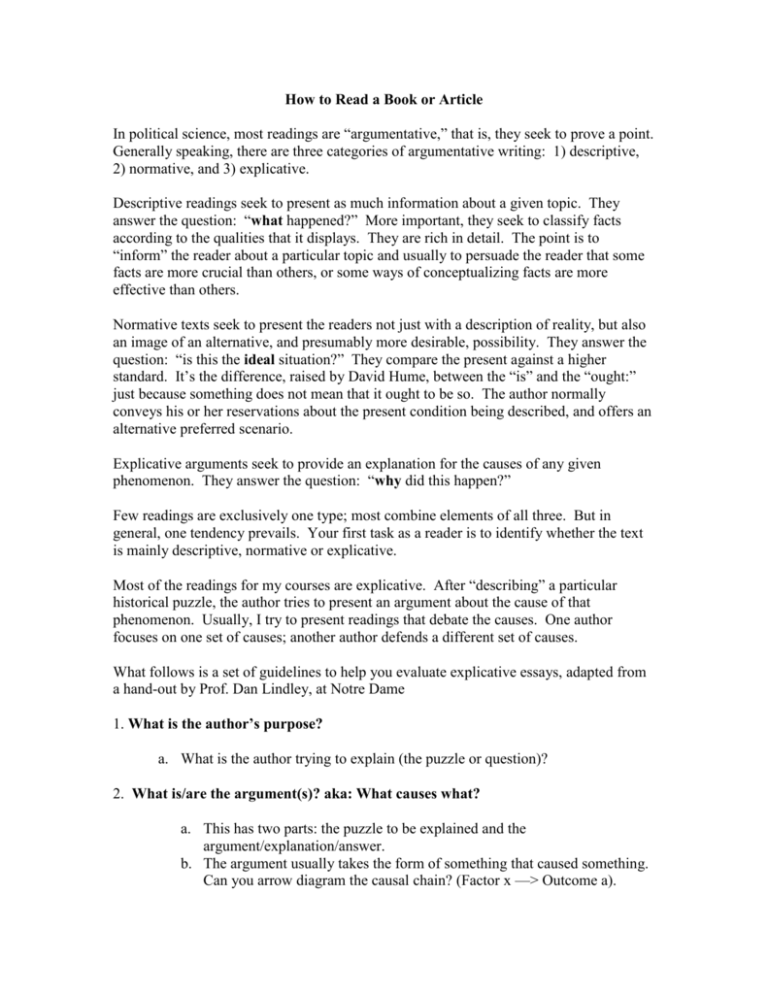How to Read
advertisement

How to Read a Book or Article In political science, most readings are “argumentative,” that is, they seek to prove a point. Generally speaking, there are three categories of argumentative writing: 1) descriptive, 2) normative, and 3) explicative. Descriptive readings seek to present as much information about a given topic. They answer the question: “what happened?” More important, they seek to classify facts according to the qualities that it displays. They are rich in detail. The point is to “inform” the reader about a particular topic and usually to persuade the reader that some facts are more crucial than others, or some ways of conceptualizing facts are more effective than others. Normative texts seek to present the readers not just with a description of reality, but also an image of an alternative, and presumably more desirable, possibility. They answer the question: “is this the ideal situation?” They compare the present against a higher standard. It’s the difference, raised by David Hume, between the “is” and the “ought:” just because something does not mean that it ought to be so. The author normally conveys his or her reservations about the present condition being described, and offers an alternative preferred scenario. Explicative arguments seek to provide an explanation for the causes of any given phenomenon. They answer the question: “why did this happen?” Few readings are exclusively one type; most combine elements of all three. But in general, one tendency prevails. Your first task as a reader is to identify whether the text is mainly descriptive, normative or explicative. Most of the readings for my courses are explicative. After “describing” a particular historical puzzle, the author tries to present an argument about the cause of that phenomenon. Usually, I try to present readings that debate the causes. One author focuses on one set of causes; another author defends a different set of causes. What follows is a set of guidelines to help you evaluate explicative essays, adapted from a hand-out by Prof. Dan Lindley, at Notre Dame 1. What is the author’s purpose? a. What is the author trying to explain (the puzzle or question)? 2. What is/are the argument(s)? aka: What causes what? a. This has two parts: the puzzle to be explained and the argument/explanation/answer. b. The argument usually takes the form of something that caused something. Can you arrow diagram the causal chain? (Factor x —> Outcome a). c. Can you summarize the argument in one or two paragraphs. 3. How logically valid are the arguments? a. Is the causal chain plausible? 1. Could one imagine a different argument, saying that Factor x ought to cause something else (say Outcome –a). Or perhaps, the arrow goes in the opposite direction: Factor A causes outcome A). 2. What does the argument assume? What preconditions must exist for the theory/argument to work? Given the assumptions, is the argument still interesting or does it assume a tautological or garbage in, garbage out quality? b. Are there any alternative explanations for the phenomena being explained? 4. Are the arguments empirically well supported? a. b. c. d. How well does the evidence match the predictions? Are there facts that the argument cannot explain as well? Can the argument explain certain facts better than other arguments 5. What would it take to falsify the argument (i.e., prove it wrong)? a. Can you identify any piece of evidence, that if found, would prove the argument to be wrong. Does the argument specify the conditions under which it would be wrong. For example, if the argument Factor X Outcome A is right, then it should be true that Factor –X should not cause A. Strong arguments are those can be stated both in its positive way (e.g., studying hard causes good grades) and in negative ways (not studying hard causes bad grades). If someone gets good grades without studying hard, then there is a weakness in the argument. It could very well be that studying hard is just one possible cause, out of many. We still need to discover other causes. b. How well do the findings stand up to counterfactual analysis? What would have happened in the absence of the Factor X or its value had been different? c. How could the argument be modified to strengthen it? 5. Does the author “refute” alternative arguments (opposing views)? a. To refute an argument means to show the weakness, invalidate or make less credible any opposing views. b. To assess whether good refutation exists, consider these two questions: First, does the author must present the alternative argument in its strongest version (rather than simply provide a caricature of it)? Second, does the author make a good case as to why his or her argument is more powerful? 6. Necessary vs. Sufficient vs. Contributing conditions a. Causes can be classified as necessary, sufficient or contributing. b. A “necessary” cause must exist for the outcome to happen: in the absence of a necessary condition, the outcome cannot occur. c. A “sufficient” cause is one that, when present, will always cause the outcome. For instance: Heat is a necessary but not sufficient condition for cooking. Rain is a sufficient but not necessary condition for wet grass. d. A “contributing” cause is factor that increases the chances that an outcome might happen, usually provided other factors are present. For example, stress contributes to catching a cold, but it is neither sufficient nor necessary for catching a cold. e. Think about this question: is “studying” a necessary, a sufficient or a contributing cause of good grades? NOTES:






